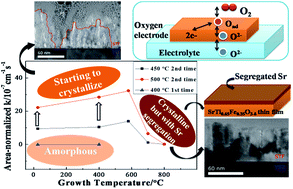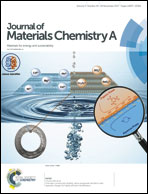Impact of microstructure and crystallinity on surface exchange kinetics of strontium titanium iron oxide perovskite by in situ optical transmission relaxation approach†
Abstract
The rate of oxygen exchange at the surface of mixed conductors is a critical property impacting the performance of elevated temperature energy conversion/storage devices. Microstructural features, such as grain boundary density and crystalline quality, are expected to impact the surface exchange kinetics, but their effect has not yet been widely studied. In this work, mixed conducting perovskite SrTi0.65Fe0.35O3−δ (STF35) thin films grown by pulsed laser deposition were applied as a model system to systematically study the effect of microstructure on oxygen surface exchange kinetics. The impact of growth temperature on crystalline quality, orientation, grain size, surface roughness, and surface chemistry was evaluated by X-ray diffraction, scanning probe microscopy, transmission electron microscopy, and angle-resolved X-ray photoelectron spectroscopy (AR-XPS). A contact-free, continuous, in situ optical transmission relaxation approach was then applied to quantify the films' native surface oxygen exchange coefficients (kchem). Amorphous films, grown at low temperatures (25 °C), did not exhibit measurable oxygen exchange ability. Highly crystalline films, grown at high temperatures (800 °C), exhibited reasonable, but not optimal kchem. The most rapid kchem was found for intermediate growth conditions, i.e., for amorphous-grown thin films just after crystallization at higher temperatures (550 °C) or for films grown near (580 °C) the crystallization temperature. Combined with the AR-XPS results showing greater surface Sr concentrations in films grown at higher temperatures, results suggest rapid kchem is obtained as a trade-off between good crystalline quality and low Sr surface concentration. Degradation of kchem over time was correlated to increased Sr surface concentration. Additionally, (100)-oriented epitaxial vs. nano-columnar grained (110)-oriented thin films with excellent crystalline quality exhibited very similar kchem and aging behavior, suggesting that neither grain boundaries nor film orientation cause observable changes in surface exchange kinetics in this composition.



 Please wait while we load your content...
Please wait while we load your content...